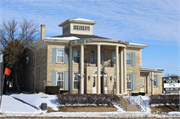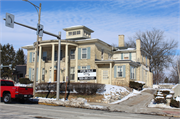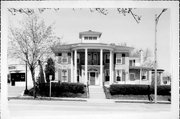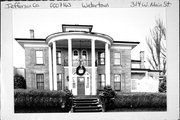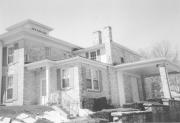Property Record
314 W MAIN ST
Architecture and History Inventory
| Historic Name: | PATRICK ROGAN HOUSE |
|---|---|
| Other Name: | BOYLE-NELSON FUNERAL HOME |
| Contributing: | |
| Reference Number: | 7163 |
| Location (Address): | 314 W MAIN ST |
|---|---|
| County: | Jefferson |
| City: | Watertown |
| Township/Village: | |
| Unincorporated Community: | |
| Town: | |
| Range: | |
| Direction: | |
| Section: | |
| Quarter Section: | |
| Quarter/Quarter Section: |
| Year Built: | 1860 |
|---|---|
| Additions: | 1936 |
| Survey Date: | 19992023 |
| Historic Use: | house |
| Architectural Style: | Italianate |
| Structural System: | Masonry |
| Wall Material: | Cream Brick |
| Architect: | Frank S. Moulton |
| Other Buildings On Site: | |
| Demolished?: | No |
| Demolished Date: |
| National/State Register Listing Name: | Not listed |
|---|---|
| National Register Listing Date: | |
| State Register Listing Date: |
| Additional Information: | A 'site file' exists for this property. It contains additional information such as correspondence, newspaper clippings, or historical information. It is a public record and may be viewed in person at the Wisconsin Historical Society, Division of Historic Preservation-Public History. This house was built for Patrick Rogan, an important pioneer who constructed a sawmill at the middle dam site, and who owned a considerable portion of land on the west side of the river that became the west side of Watertown. Patrick Rogan was also a member of Wisconsin's first constitutional convention, a state legislator, and a postmaster. He came to Watertown in 1836, one of the earliest settlers in the community. He and his two brothers, James and Peter, were instrumental in establishing the new community of Watertown. As an early settler, Patrick Rogan helped begin the fledgling community of Watertown, and with his erection of a sawmill, he helped begin the industrial base of the community. He was also important for his landholdings on the west side of the river, a part of Watertown that today makes up much of the west side of town. While his house has changed some since it was first erected for him, it is significant for its association with pioneer resident Patrick Rogan. Originally an 1860s Italianate house built for a prominent early citizen of Watertown, Patrick Rogan, this house was given a Neo-classical character with the addition of the curved, two-story portico featuring colossal Tuscan columns and balustrade on the roof in 1936. Brick lintels over the six over six windows (exterior shutters have been removed), paired arched windows on the second story and a projecting decked entrance featuring an elliptical arched overlights and sidelighted door are additional classical influenced characteristics. The hip roofed cupola displaying arched windows attest the earlier Italianate character of the Rogan house. A porte cochere added in 1936 and a one-story brick and wooden addition are located on the east side. The front portico and car port were added in the 1940s when the home was used as a funeral home. 2023: The porte cochere was removed c. 2018. |
|---|---|
| Bibliographic References: | (A) Evelyn Ruddick Rose, Our Heritage of Homes, (Watertown Historical Society, 1980), pp. 23-24. (B) Watertown Daily Times Dec. 6, 1876; Jan. 4, 1936. (C) Watertown Daily Times, Centennial Issue, 1834-1954, p. 44. |
| Wisconsin Architecture and History Inventory, State Historic Preservation Office, Wisconsin Historical Society, Madison, Wisconsin |

